Herbs in Norwegian farmhouse ale
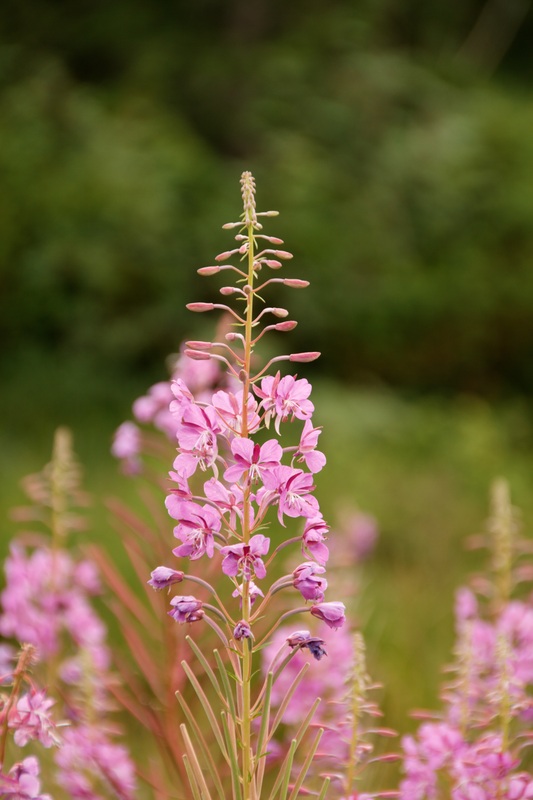
Unknown flower, Molde, Norway |
If you look at books on herbs, and even quite a few books on traditional brewing, it seems like just about every herb known to man has at one time been used in brewing. Which, given how many people were brewing over how long a period of time, might well be true. However, if you try tracing this information backwards to see what it's based on, you draw a blank. The only thing you see are these endlessly repeated assertions that such and such a herb was used in brewing. How reliable is that?
And as I've argued before, that a herb was used in beer is not in itself sufficient information. If one person did it once, and then never again, probably the result wasn't very good. If it became common over a bigger area, probably it worked well. Unfortunately, hardly anyone seems to have looked seriously at that.
Not only that, but we should know in what type of beer they were used, which parts of the plant were used, when to harvest it, how to add it to the beer, and how much to use. Sadly, none of the floras or beer books go into this, or, when they do, it's not based on the tradition. Which is a shame, seeing as the tradition is the result of centuries of experimentation.
This is where the 1950s survey of Norwegian farmhouse brewers comes in handy. It gives us quite a lot of data on brewing in the period 1850-1950 which we can mine to see what clues we can gather. One of the questions is "Do people remember if other plants besides hops have been used to add flavour to the beer?" Below I made a diagram counting the number of replies which say they know or think an ingredient has been used.
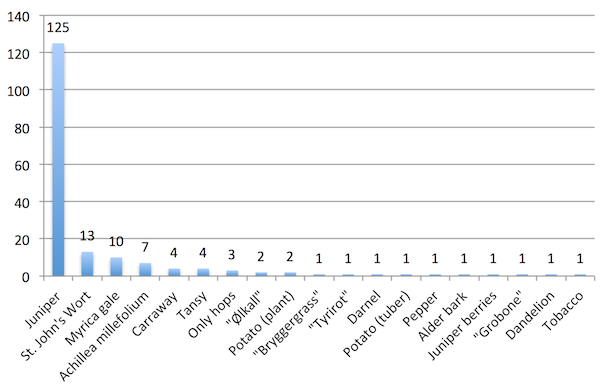
Diagram of survey answers |
As you can see immediately, next to juniper all the other herbs are relatively rare. In fact, out of 128 answers which give enough information on this point to be useful, 125 say juniper was used. Not only that, but for all the other herbs the replies say things like "some people use it", "my grandma said she heard of people using it", or even "people must have used it in the past". Juniper, on the other hand, is explicitly included in the recipes given in almost all 125 of these replies. So the dominance of juniper is even greater than the numbers suggest.
In fact, of the other ingredients, only once do I recall seeing the ingredient mentioned as part of the recipe. In the other cases people only mention these herbs when pressed, which suggests that they don't normally use them. That matches my experience with visiting traditional brewers over the last couple of years. It also matches the dozens of recipes I've dug up from various sources. None of those mention any sorts of herbs, either.
So ingrained is the use of juniper that many respondents, when asked what's used to add flavour to the beer beyond hops, completely forget to mention the juniper. Even though they five questions later specify that, "yes, juniper infusion was always used." One hastily amends his "hops only" answer by adding "But juniper was so to speak a fundamental ingredient in brewing together with malts and hops." In other words, it's so central he doesn't even think of it as an additive.
On the headings below I'll put the number of replies in parentheses after the name.
Hops (127)
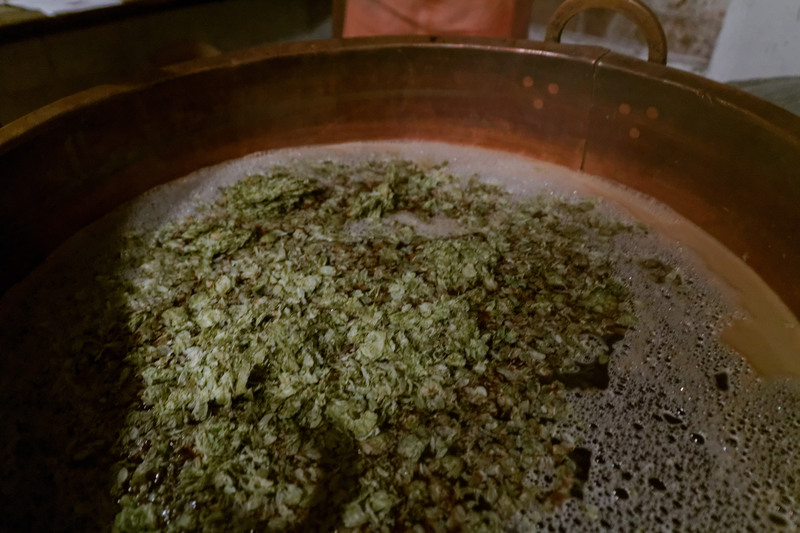
Hops in the kettle, Kaupanger, Norway |
All the replies say hops were used, except one, but that reply is generally very terse and it may simply be that the respondent did not know much about brewing beer. Not entirely sure what to make of this reply. However, in general very little hops was used. So little, in fact, that it mainly served to protect against infection, and probably added very little aroma, or even bitterness. Most of the bitterness would come from the next ingredient.
Juniper (125)
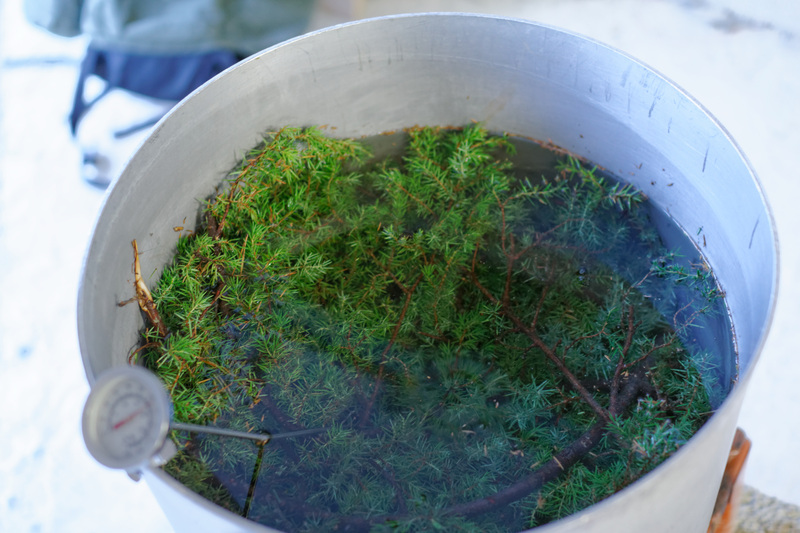
Making juniper infusion, Rælingen, Norway |
I've written about juniper before, and note that it's Juniperus communis, but let's recap quickly. You use branches, with green needles, usually the thinner branches. It doesn't seem to matter what time of year you collect the juniper, but people usually do it a few days before brewing. You use enough to fill the kettle pretty well, but without squeezing the juniper together. And you use it to make juniper infusion for the mashing and sparging, plus a few branches in the mash to serve as a filter.
There's a lot of variation in how people want the juniper, but at least the above is common, and works. In some parts of the country the infusion is boiled for hours, while in other parts they don't go above 80C.
Anyway, I think we can fairly conclude that while Norwegian farmhouse ale without juniper infusion is not totally anomalous, neither is it normal.
St. John's Wort (13)
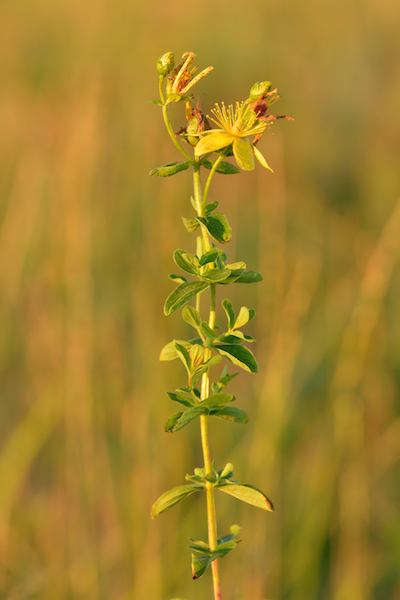
Hypericum maculatum, by Ivar Leidus, CC BY-SA |
In Norwegian this is called "perikum," but unfortunately it's a genus with 490 different species. Only 5 of these grow in Norway, which makes things easier, and a respondent kindly specifies the Latin name Hypericum quadrangulum. Unfortunately, that particular name is ambiguous, but from various clues I think I can establish that Hypericum maculatum, spotted St. John's-wort, is meant.
Sadly, the answers contain precious little useful information about how to use it. Most just say it used to be used, they heard of it being used, they assume it must have been used, etc. Some say it was used for colour, some for taste. One reply says it was "mixed in the malts," so presumably that means it was added to the mash. Another says it was "mixed with the beer," which seems to mean it was added after fermentation.
Here an anecdote comes in handy. The story is told of an old parson going senile who loves St. John's wort in his beer, and at a party of some sort, he happily crunches away at the flies in his beer, saying "I do so enjoy the taste of St. John's wort in my beer." The crunchy part of the plant seems to be the stem, which does give a nice red colour. So presumably whole plants were used (minus the root, obviously). And since the crunchy bits were still in there at the time of consumption, presumably the plant bits really were added after fermentation, as the reply above seemed to indicate.
One of the respondents also reports really enjoying the flavour of this herb, so I think this is one that's worth trying, particularly as it's also the most commonly mentioned.
Myrica gale (10)
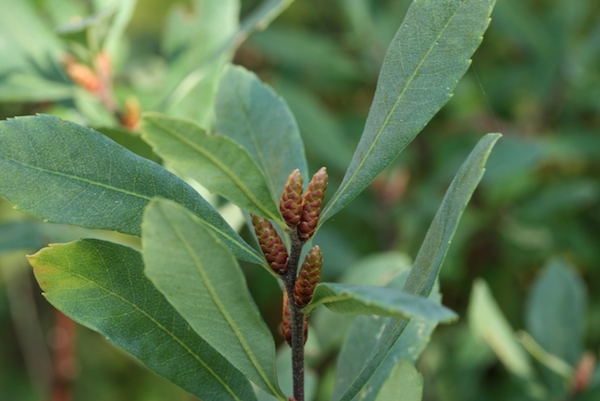
|
This is a plant with a very long tradition for use in beer, going back to way before hops were used. In fact, it was found in Danish "proto-beer" from 1500 BC, and it's been described as historically the second main additive to beer after hops. Which I'm sure is accurate, and its use seems to have never died completely in Norway, although by 1900 it must have been quite rare.
Again details on how to use it are very sparse. One reply helpfully says "it was picked in autumn with leaves on". Several answers claim it was used to make the beer intoxicating (so you felt it in your head), and one hints that it gave headaches. This thing about headaches is repeated over and over in all kinds of historical sources from the 18th and 19th centuries, so there seems to be some substance to it. The answers don't say what part of the plant to use, but I've seen historical sources say the flowers were used, while other sources say the berries were used.
Home brewer Micro Maid made a Myrica beer for the Norwegian home brewing championship last year that won the prize for Audience Favourite. She used leaves picked in the forest, crushed in a kitchen blender, 23 grams for 26 liters of beer, boiled for 25 minutes. I tried the beer, and it really was excellent, with a lovely fruity flavour, not entirely unlike lime or yuzu. I never heard of this beer giving anyone a headache. The base beer was a helles bock brewed with lager yeast and a step mash. See recipe.
Jes Rønnow Lungskow has experimented with herbs in beer and he also says to add the Myrica during the boil, and adds that it's very bitter and fragrant. He recommends just 3-5 grams per 20-25 liters.
Achillea millefolium (7)
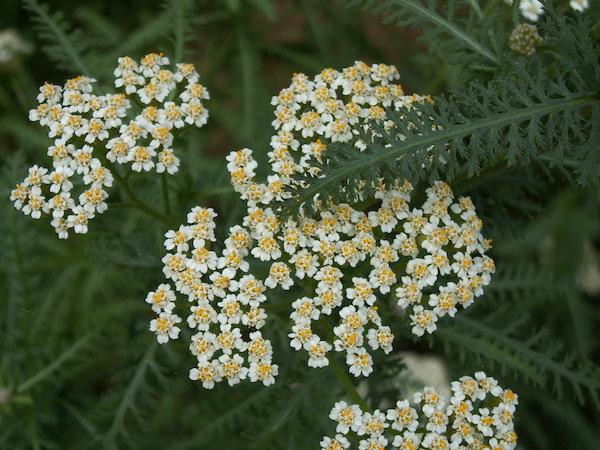
Achillea millefolium, by Lorenzarius, CC BY-SA |
Known as "ryllik" in Norwegian this plant clearly has a history of use, but the replies contain nothing beyond "they used it if they didn't have enough hops" and "some used it to add flavour". Those are actually the most concrete responses.
Carraway (4)
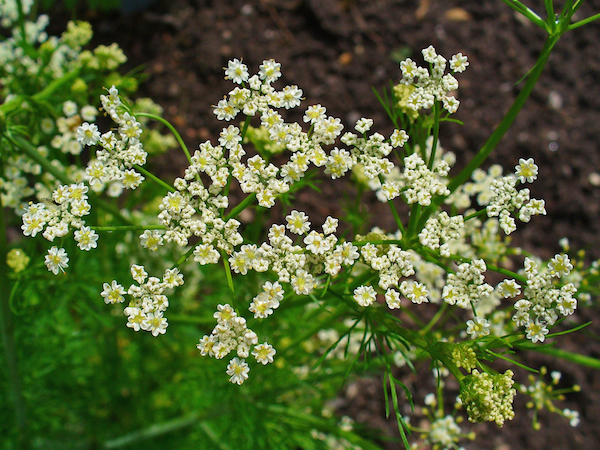
Carum carvi, by H. Zell, CC BY-SA |
This was traditionally a very popular plant for making herbal tea, and there is a bit more substance to the answers on this one. One reply includes it in the recipe and makes clear that you would use "a sprig" (doesn't sound like very much) in making the juniper infusion. Another says his mother used to add "a bunch" (so more than just a sprig) as part of the filter in the mash tun. A third reply says "some had a very little carraway in the beer". Whether that means they added it at the end is not clear.
I had a carraway beer at the Labietis brewpub in Riga, and thought it was quite good. From the flavour I would imagine that carraway would fit a wheat beer, or maybe even a wit.
Tansy (4)
Known as "reinfann" in Norwegian, this plant has clearly been used, but beyond two responses saying it was used to add a sharp flavour the survey tells us nothing more. Wikipedia says it smells of spice, so it might be worth a try.
The rest
Now we're down at the point where only 1-2 responses mention each ingredient, so I'll pass over the ones about which there's nothing much to say and concentrate on the ones that actually have some substance to offer.
Two replies say some people would use a little dried potato plant (the bit above ground) in the infusion to add colour. The second one goes on to add "this didn't give any good flavour, but the colour was so lovely." Hardly a ringing endorsement.
One respondent says "Others used potatoes. [unreadable] the potato beer was black in colour and so thick that it was not easy to drink."
The same respondent adds: "Some put tobacco on the bottom of the cask, but that beer wasn't [unreadable], it made you vomit." That sounds odd, because I've seen reports that tobacco was occasionally used in the Baltics and Finland. And I've had beer with a little tobacco in it with no ill effects. But maybe they used a lot. Who knows.
In short, I think we can take this survey to mean that in the period 1850-1950 additives other than hops and juniper were relatively rare. My guess would be that St. John's Wort, myrica, and carraway definitely were used to some extent, and maybe achillea, too. Unfortunately, nearly all the knowledge of how to use these herbs has disappeared, so experimentation will be needed to figure out how and where to use them.
There is, however, a good bit of evidence that there was more usage of these herbs (and a few others) in the past.
I stand by my earlier claim that farmhouse ales have a lot more to offer modern brewing on the process and normal beer style development side than with special ingredients like these. But they might still be worth a try.
Similar posts
Norwegian Ethnological Research
The definitive book on Norwegian farmhouse ale is Odd Nordland's "Brewing and beer traditions in Norway," published in 1969
Read | 2014-09-15 15:38
The Mystery of the Pierced Planks
In March 2021 Norwegian archaeologists posted the photo above on Facebook, asking their followers what they thought these planks might have been used for
Read | 2022-10-01 12:54
The juniper mystery
When I started looking at farmhouse ale back in 2010, one of the first things that struck me was that nearly everyone seemed to be using juniper
Read | 2017-02-02 09:43
Comments
Dave Bonta - 2015-04-13 10:00:33
Thanks for summarizing this! My own experience of brewing with various herbs over the past 20 years suggests that while many herbs can be added to beer with pleasant results, only a few have antiseptic qualities approaching those of hops. So my tendency has been to gravitate toward just a few of these where I can get a supply of reliable and consistent quality, which is really difficult with mail-order herbal supply companies. Two of my favorites, for example -- yarrow and mugwort -- I can gather in my own field, and have learned that strength and flavor vary a lot depending on when they're picked (both time of year and time of day). Myrica gale I've had to buy from brewing herb suppliers, and it's always too old and harsh to be of much use except as a background antispetic agent.
Lars Marius - 2015-04-13 10:11:34
@Dave: I think you're right about the antiseptic qualities. People say all sorts of herbs have antiseptic qualities, but the only test I've seen was for juniper, where the conclusion was that it had no antibiotic effect.
And you might be right that getting fresh ingredients is important. That's one point I forgot to make in the post.
Matt - 2015-04-13 12:25:27
Achillea millefolium is also known as Yarrow and it has a pretty good history of use in beer before hops. My understanding is that it was a somewhat common herb in the various gruit mixes.
Lars Marius - 2015-04-13 12:30:38
@Matt: Thanks for adding the name "yarrow". I forgot to do that. And, yes, yarrow is generally considered the most prominent in gruit.
Martin Warren - 2015-04-15 22:18:08
Rosebay willowherb, Chamerion angustifolium
http://paulkirtley.co.uk/2013/rosebay-willowherb-taking-the-pith/
Lars Marius - 2015-04-16 02:19:55
@Martin: Ah, yes, that's what the flower at the top is. Thank you. Geitrams in Norwegian.
Aaron Brussat - 2015-04-16 16:54:28
I read in Buehner's Sacred & Herbal Healing book that St. John's wort was laced, probably along with juniper boughs, on the bottom of the mash tun to help filter the wort. I tried that once... the beer did not turn out well, but due to other issues. St. John's Wort has long been used as an antidepressant, but can have the side effect of light-sensitivity in some people. Good use of an invasive plant (here in the US)!
Lars Marius - 2015-04-16 17:06:00
@Aaron: Buehner could very well be right, but I would love to see some sources cited. How does he know? I've been searching every source I can find for a while now, and still I have not a single mention anywhere of anyone saying "I use St John's Wort" in any way whatsoever, nor any certain reference to how it was used.
qq - 2017-02-15 19:56:35
Probably worth mentioning that Myrica gale, or bog myrtle, should not be consumed by pregnant women as it can cause them to lose the baby : http://www.pfaf.org/user/Plant.aspx?LatinName=Myrica+gale
Seems to have been pretty standard in Scottish gruits, apparently it helps head formation* aside from the flavour aspect. I love the smell of it fresh, it's a real smell of childhood, but dried is definitely a different thing. I never knew you could produce enough wax from them to make candles.
*PFAF reference Facciola. S. Cornucopia - A Source Book of Edible Plants. Kampong Publications 1990 ISBN 0-9628087-0-9
randomaccountgenerator - 2017-03-23 06:51:56
St Johns wort was used as a bittering herb most likely, however it was added. If you've ever drunk the tea straight without sugar, you notice how bitter but pleasant it can be. This plant is still very popular as a herbal tea in the Balkans.
I would guess that it was added, like others in gruit, to take the sweet edge off unhopped ale. I make lots of strong, low hopped,<5 IBU ale and love to experiment with other herbs to take the edge off, St Johns Wort is one of them, along with Juniper berries, Linden (Lime) flowers, Liquorice root, Mugwort leaves and Coriander seed.
As an aside, I personally think Juniper (berries in my case) go best with stouts regardless of hopping rates. I'm surprised no commercial companies are making it.
Hans Mikkel Melhus - 2017-04-29 15:24:52
Great and impressive blog! I find your work on old beer traditions really important and interesting. I remember reading a book about herbs where Carl LinnÚ said that he preferred rylikk over hops in beer. Just a funny side track. And isn't mj°durt a quite common beer herb or am I mistaken?
Lars Marius Garshol - 2017-04-29 16:15:17
Thank you, Hans Mikkel. There are reasons to think Filipendula ulmaria (mj°durt) probably was used in beer. It definitely was used in mead in ancient times. But the blog post summarizes all the evidence I had at that point for herbs in Norwegian beer. I have a lot more evidence now, but there's still nobody who has written "people here used meadowsweet (mj°durt) in their beer" that I've been able to find.
Stan - 2017-05-02 14:06:01
Unknown flower in first photo is:
Chamaenerion angustifolium, commonly known in North America as fireweed, in some parts of Canada as great willowherb,[1] and in Britain as rosebay willowherb,[2] is a perennial herbaceous plant in the willowherb family Onagraceae. It is also known by the synonyms Chamerion angustifolium and Epilobium angustifolium.
BruSkald - 2017-07-08 02:24:57
Hi Lars,
The purple flower pictured at the top of your post is not unknown to me...as it actually was my choice of botanical for the very first Raw Farmhouse Ale that I have ever produced!
It's Fireweed...also known as Willow Herb. The best honey I've ever tasted from British Columbia, Canada is Fireweed Honey...as the flowering plant is quite prolific here.
Bru